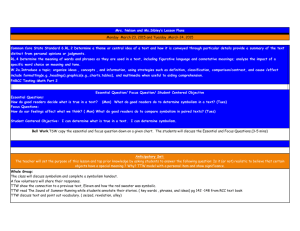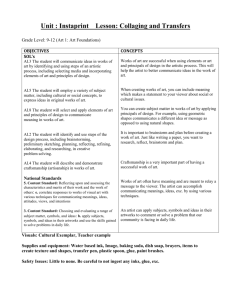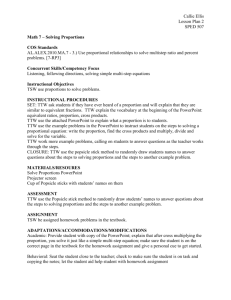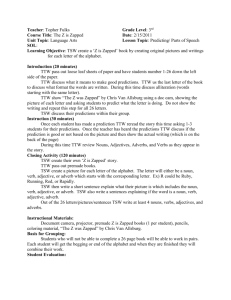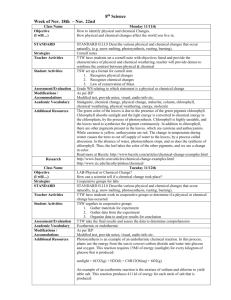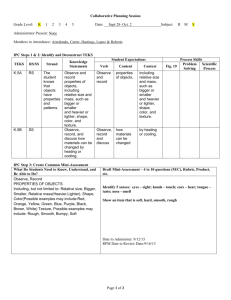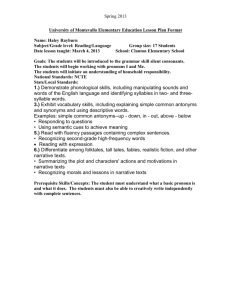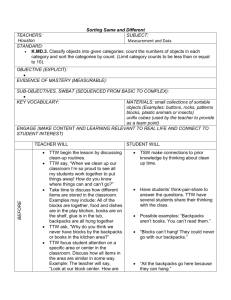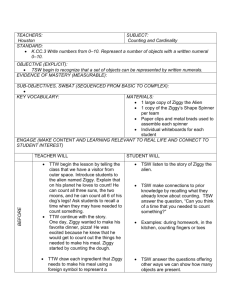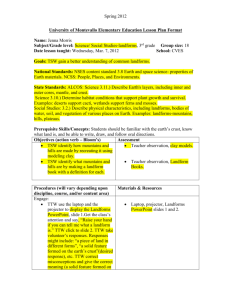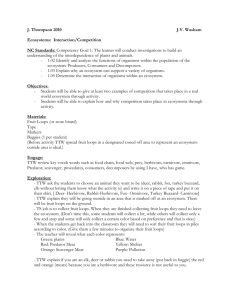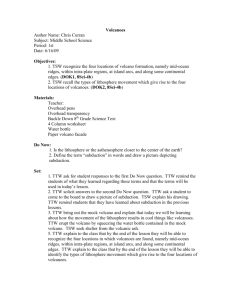ED508LessonPlan#2
advertisement
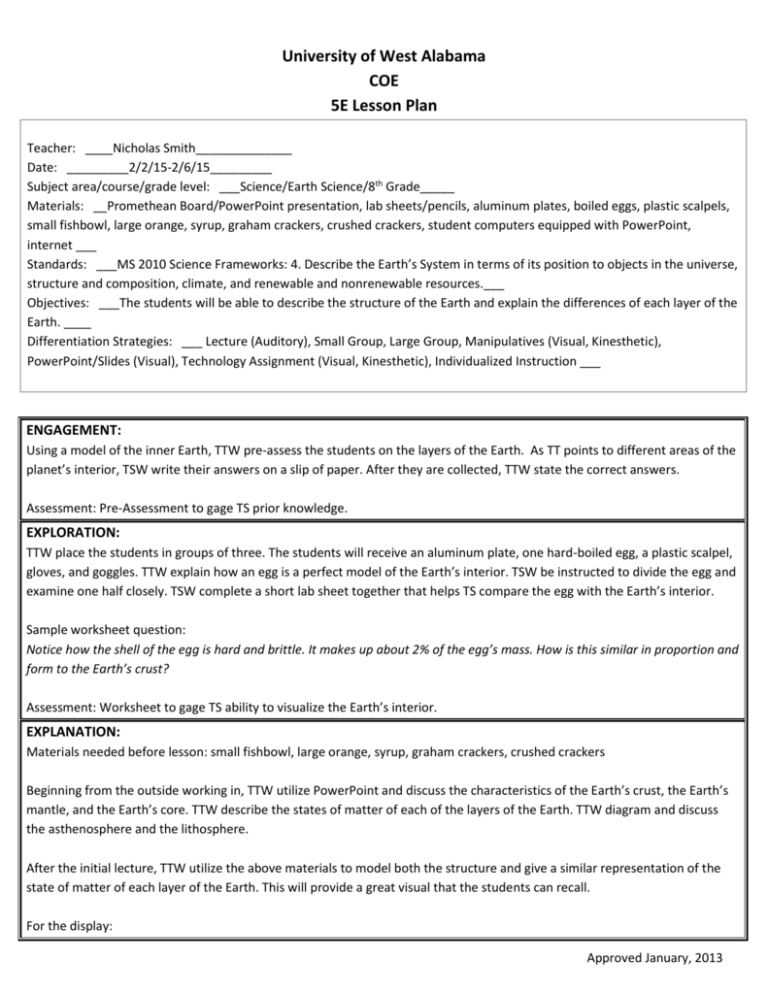
University of West Alabama COE 5E Lesson Plan Teacher: ____Nicholas Smith______________ Date: _________2/2/15-2/6/15_________ Subject area/course/grade level: ___Science/Earth Science/8th Grade_____ Materials: __Promethean Board/PowerPoint presentation, lab sheets/pencils, aluminum plates, boiled eggs, plastic scalpels, small fishbowl, large orange, syrup, graham crackers, crushed crackers, student computers equipped with PowerPoint, internet ___ Standards: ___MS 2010 Science Frameworks: 4. Describe the Earth’s System in terms of its position to objects in the universe, structure and composition, climate, and renewable and nonrenewable resources.___ Objectives: ___The students will be able to describe the structure of the Earth and explain the differences of each layer of the Earth. ____ Differentiation Strategies: ___ Lecture (Auditory), Small Group, Large Group, Manipulatives (Visual, Kinesthetic), PowerPoint/Slides (Visual), Technology Assignment (Visual, Kinesthetic), Individualized Instruction ___ ENGAGEMENT: Using a model of the inner Earth, TTW pre-assess the students on the layers of the Earth. As TT points to different areas of the planet’s interior, TSW write their answers on a slip of paper. After they are collected, TTW state the correct answers. Assessment: Pre-Assessment to gage TS prior knowledge. EXPLORATION: TTW place the students in groups of three. The students will receive an aluminum plate, one hard-boiled egg, a plastic scalpel, gloves, and goggles. TTW explain how an egg is a perfect model of the Earth’s interior. TSW be instructed to divide the egg and examine one half closely. TSW complete a short lab sheet together that helps TS compare the egg with the Earth’s interior. Sample worksheet question: Notice how the shell of the egg is hard and brittle. It makes up about 2% of the egg’s mass. How is this similar in proportion and form to the Earth’s crust? Assessment: Worksheet to gage TS ability to visualize the Earth’s interior. EXPLANATION: Materials needed before lesson: small fishbowl, large orange, syrup, graham crackers, crushed crackers Beginning from the outside working in, TTW utilize PowerPoint and discuss the characteristics of the Earth’s crust, the Earth’s mantle, and the Earth’s core. TTW describe the states of matter of each of the layers of the Earth. TTW diagram and discuss the asthenosphere and the lithosphere. After the initial lecture, TTW utilize the above materials to model both the structure and give a similar representation of the state of matter of each layer of the Earth. This will provide a great visual that the students can recall. For the display: Approved January, 2013 TTW ask: Which of these would be a good representation of the Earth’s inner core? Why? (TTW place the orange in the fish bowl to simulate the core.) TTW ask: How are the viscosities of this syrup and magma similar? (TTW pour the syrup over the orange simulating the viscosity of magma.) TTW ask: How does the lithosphere move with the asthenosphere? (TTW place a layer of graham crackers on the syrup to represent how the lithosphere floats on top of the asthenosphere.) TTW ask: How does the crushed crackers represent the Earth’s crust? (TTW empty the crushed crackers on the graham crackers explaining how the lighter material makes up the crust.) Assessment: Large group Q and A session-informal ELABORATION: TSW be grouped into threes. Each group will have a student responsible for content, a student responsible for technology, and a student responsible for time management and creativity. TSW be instructed to create a PowerPoint that gives a “tour” of the Earth’s interior. TSW use information from the lesson, text, and internet to briefly explain each layer of the Earth. The required slides are: crust, lithosphere, asthenosphere, mantle, inner core, and outer core. Required information will be a brief description, the thickness of the layer, and the state of matter that the layer is in. Each slide must contain at least one picture that adds to the visual effect and helps portray the appropriate feeling. A rubric will be used for grading. Assessment: Formal-PowerPoint Tour graded with rubric EVALUATION: Lesson direction will be determined by the prior knowledge assessment. Students will be informally assessed during group discussion and Q and A to determine what items need re-teaching and further explanation. The worksheet will help determine the students’ ability to visualize a concept they cannot see. Using a rubric, TTW formally assess the students’ PowerPoint assignment to determine understanding. The students will be able to describe the structure of the Earth and explain the differences of each layer of the Earth with 90% accuracy. References: Bybee, R.W. et al. (1989). Science and technology education for the elementary years: Frameworks for curriculum and instruction. Washington, D.C.: The National Center for Improving Instruction. Bybee, R. W. (1997). Achieving Scientific Literacy: From Purposes to Practices. Oxford: Heinemann. National Research Council. (1999). Inquiry and the national science education standards: A guide for teaching and learning. Washington, D.C.: National Academy Press. Polman, J.L. (2000). Designing project-based silence: Connecting learners through guided inquiry. New York: Teachers College Press. Approved January, 2013
